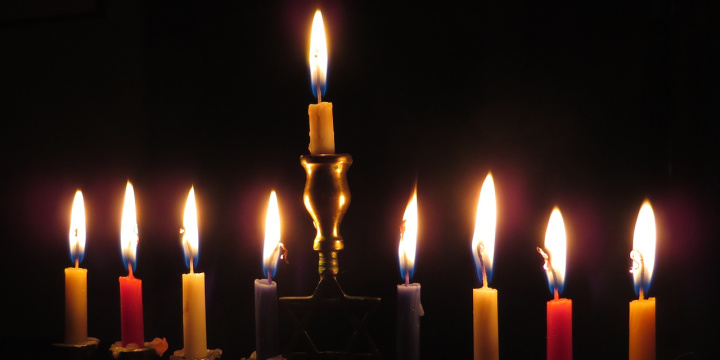How Hanukkah & Christmas Affirm the Jewish People’s Connection to the Land of Israel
 by Chaim Lax
by Chaim Lax
Although Christmas and Hanukkah are observed by two separate religions, are celebrated according to two different calendars, and commemorate two different religious events, both holidays have one thing in common: They highlight the Jewish people’s ancient connection to the Land of Israel.
In the week prior to the beginning of Hanukkah this year, the Israeli Antiquities Authority announced that a recent dig in the Judean Desert had unearthed a trove of ancient coins dating back to the tumultuous period prior to the Maccabean revolt in 167 BCE.
According to archaeology experts, this discovery is concrete evidence for the story told in the Book of Maccabees, of pious Jews fleeing to the desert to escape the persecution of the Seleucid Empire under Antiochus IV.
However, this cache of silver coins not only corroborates the Hanukkah story but, like the Hanukkah story itself, is further proof of the ancient ties of the Jewish people to the Land of Israel.
The Hanukkah story is essentially a traveling map of the Land of Israel. The story opens as Mattathias and his sons begin their revolt against the Seleucids and their Hellenist allies in the town of Modi’in (located near the central Israeli city that bears the same name).
After the revolt was declared, the band of Jewish rebels (known as the Maccabees) fled to the Gofna hills (near the modern-day Jewish community of Beit El) in order to set up a para-military camp to be used as a base for their fight against the Seleucids.
From this camp, the Maccabees engaged in a number of battles from which they emerged victorious. These battles took place at Maaleh Levona (near the modern-day Israeli city of Ariel), Bet Horon (located between Modi’in and Jerusalem), and Beit Tzur (located in the hills surrounding Hebron).
Following these victories, the Maccabees successfully liberated the city of Jerusalem and re-sanctified the Holy Temple. This liberation and re-sanctification are the key events of the Hanukkah story.
Therefore, when Jews celebrate Hanukkah by lighting candles, playing dreidel, and eating oil-based foods, they are not only commemorating the miracle of the jug of oil or a remarkable military victory, but also affirming the ancient ties that bind the Jewish people to the Land of Israel, all the way through to the present day.
Just like the story of Hanukkah, the Christmas story also highlights the Jewish connection to the Land of Israel for thousands of years.
The story of the birth of Jesus, which Christmas celebrates, is based upon the words of the Gospels of Luke and Matthew, and details the lives of a Jewish family in the Land of Israel at the turn of the first century CE.
The narratives in both Luke and Matthew describe the birth of Jesus to Mary and Joseph, a Jewish couple, in the Judean city of Bethlehem. At the time, Bethlehem was thought to be a major source of agriculture for the nearby metropolis of Jerusalem, especially for produce and livestock that were brought as offerings to the Holy Temple.
Following the birth of Jesus, the narratives of Luke and Matthew diverge, with the Gospel of Matthew having Jesus’ family escape to Egypt before returning to the Land of Israel and migrating to the Galilean city of Nazareth, while the Gospel of Luke has Jesus’ family ascend to the Holy Temple in Jerusalem before venturing on to Nazareth.
In any event, the story of Jesus’ birth and the early years of his life appears within the context of a vibrant and semi-independent Jewish community existing within the Land of Israel, more than 2,000 years ago.
Thus, Christmas commemorates the birth of a Jewish child in Bethlehem, and also positively affirms the Jewish people’s connection to the Land of Israel for thousands of years.
 Columbia University Shutters Campus as Jews Fear for Safety, Critics Call for President to Resign
Columbia University Shutters Campus as Jews Fear for Safety, Critics Call for President to Resign ‘Hamas, We Love You!’ A List of the Chants, Statements From Columbia University’s ‘Gaza Solidarity Encampment’
‘Hamas, We Love You!’ A List of the Chants, Statements From Columbia University’s ‘Gaza Solidarity Encampment’ ‘Useless Pigs’: Anti-Israel Demonstrations Rage at Yale University, Forcing Police Intervention
‘Useless Pigs’: Anti-Israel Demonstrations Rage at Yale University, Forcing Police Intervention Anti-Israel Protesters Interrupt Chelsea Handler Comedy Show Because of Her Support for Jewish State
Anti-Israel Protesters Interrupt Chelsea Handler Comedy Show Because of Her Support for Jewish State Israeli Hostage Families Make Passover Plea for Return of Missing Loved Ones
Israeli Hostage Families Make Passover Plea for Return of Missing Loved Ones Palestinian Arrested for Murdering Israeli Teen in West Bank Terror Attack
Palestinian Arrested for Murdering Israeli Teen in West Bank Terror Attack A Passover Guide for the Perplexed 2024
A Passover Guide for the Perplexed 2024 Appeasing Iran Will Lead to More Attacks on All of Us
Appeasing Iran Will Lead to More Attacks on All of Us CNN Platforms Biased Journalists in Coverage of Iran, Gaza
CNN Platforms Biased Journalists in Coverage of Iran, Gaza Fatah: Hamas Kills Aid Workers and Steals Food for Itself
Fatah: Hamas Kills Aid Workers and Steals Food for Itself




 Voice of America’s Gaza War Recap Omits Vital Context
Voice of America’s Gaza War Recap Omits Vital Context Fatah: Hamas Kills Aid Workers and Steals Food for Itself
Fatah: Hamas Kills Aid Workers and Steals Food for Itself CNN Platforms Biased Journalists in Coverage of Iran, Gaza
CNN Platforms Biased Journalists in Coverage of Iran, Gaza Appeasing Iran Will Lead to More Attacks on All of Us
Appeasing Iran Will Lead to More Attacks on All of Us A Passover Guide for the Perplexed 2024
A Passover Guide for the Perplexed 2024